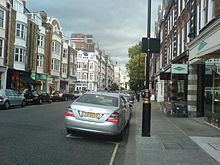OS grid reference TQ265835 Dialling code 020 UK parliament constituency Westminster North | London borough Westminster Sovereign state United Kingdom | |
 | ||
Knight frank st john s wood area and property guide
Saint John's Wood is a district of northwest London, in the City of Westminster, and on the northwest side of Regent's Park. It is about 2.5 miles (4 km) northwest of Charing Cross. Once part of the Great Middlesex Forest, it was later owned by the Knights of St John of Jerusalem.
Contents
- Knight frank st john s wood area and property guide
- Map of St Johns Wood London UK
- Octavian house st john s wood london nw8
- History
- Education
- Places of worship
- Transport and locale
- Commemorative blue plaques
- St Johns Wood in literature and music
- References
Map of St John's Wood, London, UK
The boundaries of St. John's Wood are the Regent's Canal to the south, Maida Vale (Edgware Road) to the west, Boundary Road to the north and Avenue Rd/Primrose Hill Park to the east.
It is a very affluent neighbourhood, with the area postcode (NW8) ranked by Forbes magazine as the fifth most expensive postcode in London based on the average home price in 2007. According to a 2014 property agent survey, St. John's Wood residents pay the highest average rent in all of London.
Octavian house st john s wood london nw8
History
St John's Wood was developed from the early 19th century onwards. One of the first developers in the area was James Burton. It was one of the first London suburbs to be developed with a large amount of low density "villa" housing, as opposed to the terraced housing which was the norm in London up to the 19th century, even in expensive districts. Parts of St John's Wood have been rebuilt at a higher density, but it remains a highly desirable residential district, and one of the most expensive areas of London.
St John's Wood is the location of Lord's Cricket Ground, home of Middlesex County Cricket Club and of the Marylebone Cricket Club (MCC), and the original headquarters of cricket. It is also famous for Abbey Road Studios and the street Abbey Road, where The Beatles recorded, notably the Abbey Road album, the cover of which features the band crossing the road.
The King's Troop, Royal Horse Artillery was formerly based at St John's Wood Barracks. The regiment moved to Woolwich on 6 February 2012; the barracks is to be demolished and developed as housing.
The area is also home to St. John's Wood Church Grounds, which contains the only nature reserve in the City of Westminster.
Education
The area has various schools, both state and independent:
Places of worship
St John's Wood has a range of places of worship.
Transport and locale
The nearest London Underground stations are St. John's Wood, Swiss Cottage—on the Jubilee line; Maida Vale, Marylebone Station and Warwick Avenue—on the Bakerloo line; and Baker Street on Bakerloo line, Jubilee line, Hammersmith & City line, Metropolitan line and Circle line.
The nearest London Overground station is South Hampstead.
